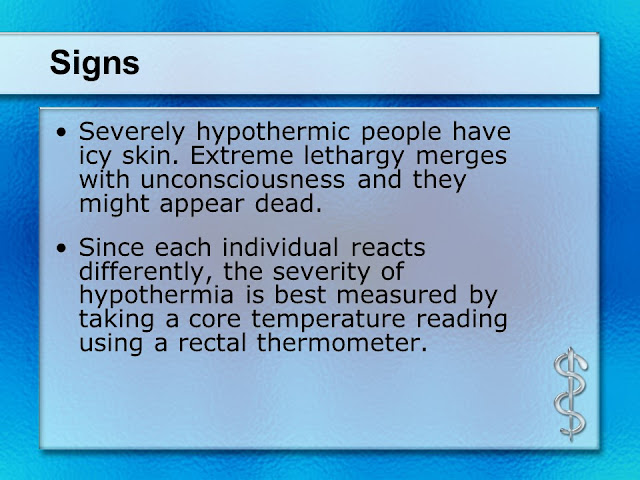HYPOTHERMIA
Dr Mind, Dr Body, Dr Eye 2016
What is hypothermia?
- Hypothermia is defined as a body core temperature less than 35 C.
- Decreased consciousness occurs when the core temperature falls to approximately 32 to 30 C.
- Normal body temperature is 37.2 C
Who is at risk for developing hypothermia?
- WE ALL ARE!!!
- BUT particularly….
- people under 16 and over 65
- alcohol use: alcohol makes you feel warm inside, but causes blood vessels to dilate, causing increased heat loss, and can upset thermoregulation
- medical illnesses that affect sensation in extremities eg feet and medications
- dehydration and jetlag
Swimming in cold water
- In cold water, heat is conducted away from the body and transferred to the water.
- Heat is lost very quickly, 25 to 30 times faster in water than air.
- Swimming ie activity further increases heat loss (increase by 35-50%)
How long can a person survive in cold water?
Water temp // Exhaustion // Survival4C-10C // 30 to 60 min // 1 to 3 hrs
10C-15C // 1 to 2 hrs // 1 to 6 hrs
15C-21C // 2 to 7 hrs // 2 to 40hrs
Hypothermia symptoms
- shivering
- clumsiness or lack of co-ordination
- slurred speech or mumbling
- confusion or difficulty thinking
- poor decision making
- lack of concern about one’s condition
- weak pulse
- shallow breathing
Swim Failure:
- Swim failure occurs when the arm muscles are cooled to the point they cease working properly
- Children and thin adults are vulnerable
- Another good reason never to swim alone!
Symptoms:
- Hypothermia sneaks up on you, so you probably aren't the best judge of whether or not you are hypothermic.
- Self awareness is your greatest asset.Resisting help and acting irrational or confused are common indicators of hypothermia.
- As your core temperature drops dangerously low, you become semiconscious, then unconscious.
- Low core body temperatures may cause cardiac and respiratory failure
Prevention:
- Have a hot drink before leaving home
- When leaving home Pack an old jacket/sweater and shoes/sandals and WEAR them. Heat loss occurs in cold air and it is important to be warm before entering the water.
- Consider if you should swim today, (the café is always a safe and social option)
- Consider how long you should swim today
- Consider who you will swim with (always swim with others ).
- Ask yourself: do I feel well?
- Ask yourself: did I have a big night last night?
- Ask yourself: how did I feel after my last swim? Is it colder? Is it rougher?
- Ask yourself: how many min. can I swim for in winter ?
- Swim within yourself.
- Wear a jacket/sweater and shoes on the pier as cold air and wind cause significant heat loss
- If you don’t feel right GET OUT
When trouble strikes
If you suspect you are developing swim failure or hypothermia:- Tell someone
- Try to stand up if the water is shallow
- Use your legs as they don’t cool, as quickly as your armsand kick to land/platform /board
Signs:
- Severely hypothermic people have icy skin. Extreme lethargy merges with unconsciousness and they might appear dead.
- Since each individual reacts differently, the severity of hypothermia is best measured by taking a core temperature reading using a rectal thermometer
Treating hypothermia
- -Be gentle and limit movements to only those which are necessary
- Get the person indoors to the steam room ASAP and dry them gently with a towel
- Lie the person down in the steam room
- Monitor breathing, pulse and brain eg Ask the person questions eg where are you?what day is it?
- Share body heat to the chest, warm the core, place warm arms across the chest
- Provide a warm drink
- DO NOT massage or rub the person
- DO NOT apply direct heat eg a hot shower
- Heat applied to the arms and legs forces cold blood back to the heart and lowers the temperature further.
- DO NOT leave the person alone
- if No pulse or Not breathing then CPR (Try for 2 min to find pulse , breathing)
- CALL AN AMBULANCE
- Don't assume the person is dead, they are only dead when they are warm and dead.
Finally:
- Good luck to us all !!!!!
- Safe winter swimming.
- “Be alert but not alarmed”



















Comments
Post a Comment